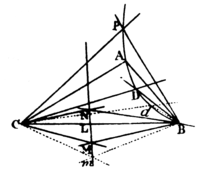The ſame otherwiſe. Pl. 9. Fig. 6.

Of the given points join any three as A, B, C; and about two of them B, C, as poles, making the angles ABC, ACB of a given magnitude to revolve, apply the legs BA, CA, firſt to the point D, then to the point P, and mark the points M, N, in which the other legs BL, CL intersect each the other in both caſes. Draw the indefinite right line MN and let thoſe moveable angles revolve about their poles B, C, in ſuch manner that the interſection, which is now ſuppoſed to be m, of the legs BL, CL, or BM, CM and always fall in that indefinite right line MN; and, the interſection which is now ſuppoſed to be d, of the legs BA, CA, or BD, CD, will deſcribe the trajectory required PADdB. For, (by lem. 21.) the point d will be placed in a conic ſection paſſing through the points B, C; and when the point m comes to coincide with the points L, M, N, the point d will (by conſtruction) come to coincide with the points A, D, P. Wherefore a conic ſection will be deſcribed that ſhall paſs through the five points A, B, C, P, D. Q. E. F.
Cor. 1. Hence a right line may be readily drawn which ſhall be a tangent to the trajectory in any given point B. Let the point d come to coincide with the point B, and the right line Bd will become the tangent required.
Cor. 2. Hence alſo may be found the centres, diameters, and latera recta of the trajectories, as in cor. 2. lem. 19.
